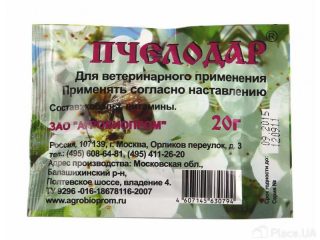Content
- 1 Application in beekeeping
- 2 Composition, release form
- 3 Pharmacological properties
- 4 Oxytetracycline hydrochloride for bees: instructions
- 5 Treatment of bees with tetracycline: dosage, rules of use
- 6 How to dilute oxytetracycline for bees
- 7 Side effects, contraindications, restrictions on use
- 8 Shelf life and storage conditions
- 9 Conclusion
Beekeeping is not as simple as it may seem. To ensure that insects reproduce well and do not get sick, beekeepers use various drugs. One of them is oxytetracycline hydrochloride. It is given to treat foulbrood (a bacterial disease). Pharmacological properties of the drug, contraindications, side effects, instructions for using oxytetracycline for bees - more on this later.
Application in beekeeping
Beekeepers use the drug to treat foulbrood diseases in their beekeepers. The most dangerous are considered to be 2 types of disease:
- American Foulbrood;
- European foulbrood.
The first danger of the disease is rapid spread. If treatment is not started in time, the entire hive may die. The disease primarily affects the larvae. They die out and remain in a putrid mass at the bottom of the hive.
The second danger is that foulbrood will soon spread to the remaining hives and even neighboring apiaries.
Composition, release form
Oxytetracycline hydrochloride appears as a brown powder.It is produced in paper bags of 2 g (for 4 bee colonies).
The main component of the medicine is the antibiotic Terramycin. Its active ingredient is oxytetracycline.
Pharmacological properties
Oxytetracycline hydrochloride is an antibacterial and antimicrobial drug. It has a bacteriostatic effect. That is, it stops the reproduction of microorganisms, which leads to their rapid extinction. It affects gram-negative and gram-positive bacteria. Oxytetracycline is not effective against Pseudomonas aeruginosa, Proteus, and yeast fungi.
Oxytetracycline hydrochloride for bees: instructions
The optimal time to treat bees with oxytetracycline is the beginning of spring, before the start of honey collection or after pumping it out. Before giving the bees an antibiotic, all sick bees are isolated in a separate house. There are 3 ways to administer the drug:
- feeding;
- dusting;
- spraying.
Judging by the reviews, the most effective method is spraying. The antibiotic powder is mixed with boiled water.
The dusting solution is prepared as follows: take starch, powdered sugar or flour. Add oxytetracycline powder there.
To prepare the formula for feeding, you need to take a small amount of warm boiled water and add an antibiotic. After mixing, add a little 50% sugar syrup.
Treatment of bees with tetracycline: dosage, rules of use
The dosage of the drug does not depend on the chosen method of treatment. For 1 frame you need to take 0.05 g of oxytetracycline hydrochloride for bees. When treating by spraying, 15 ml of solution per 1 frame is sufficient; by feeding - 100 ml.To treat the frame by dusting, the beekeeper will need 6 g of dry mixture.
Treatment is carried out once a week until complete recovery. 3 times are usually sufficient to eliminate clinical symptoms. In addition to antibiotic treatment, when treating bees it is necessary:
- disinfect equipment;
- burn waste from an infected hive;
- replace the uterus.
How to dilute oxytetracycline for bees
To treat bees by feeding, oxytetracycline is diluted in sugar syrup. Take 0.5 g of the substance per 1 liter of syrup. The antibiotic is also used for prophylactic purposes. In this case, 0.2 g of oxytetracycline per 3.8 liters of syrup is sufficient.
The spray solution is made differently. Take 50 g of antibiotic per 2 liters of warm water. The mixture is added to the water for washing the hives. 30 ml of solution is enough for 1 frame.
Side effects, contraindications, restrictions on use
The drug is contraindicated if insects have hypersensitivity to tetracyclines. It should not be given to bees during the honey collection period. There were no side effects or symptoms of overdose in insects.
Shelf life and storage conditions
The shelf life of a closed package with the drug is 2 years. It must be stored in a dry place, out of direct sunlight. The room should be at room temperature (approximately 22°C).
Conclusion
Instructions for the use of oxytetracycline for bees is easy to use. You just need to mix the medicine with water, sugar syrup or flour. Despite its simplicity, this is an effective remedy against foulbrood diseases in bees.









